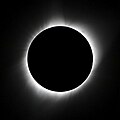| Total eclipse | |
 Partial eclipse photographed in Kabelvåg, Norway, by Celia Hammer | |
| Gamma | 0.6964 |
|---|---|
| Magnitude | 1.0392 |
| Maximum eclipse | |
| Duration | 163 s (2 min 43 s) |
| Coordinates | 54°24′N132°12′E / 54.4°N 132.2°E |
| Max. width of band | 182 km (113 mi) |
| Times (UTC) | |
| Greatest eclipse | 5:09:00 |
| References | |
| Saros | 124 (48 of 73) |
| Catalog # (SE5000) | 9272 |
A total solar eclipse occurred at the Moon's descending node of orbit on Sunday, August 9, 1896, with a magnitude of 1.0392. A solar eclipse occurs when the Moon passes between Earth and the Sun, thereby totally or partly obscuring the image of the Sun for a viewer on Earth. A total solar eclipse occurs when the Moon's apparent diameter is larger than the Sun's, blocking all direct sunlight, turning day into darkness. Totality occurs in a narrow path across Earth's surface, with the partial solar eclipse visible over a surrounding region thousands of kilometres wide. Occurring about 2.5 days before perigee (on August 11, 1896, at 18:30 UTC), the Moon's apparent diameter was larger. [1]
Contents
- Gallery
- Eclipse details
- Eclipse season
- Related eclipses
- Eclipses in 1896
- Metonic
- Tzolkinex
- Half-Saros
- Tritos
- Solar Saros 124
- Inex
- Triad
- Solar eclipses of 1895–1899
- Saros 124
- Metonic series
- Tritos series
- Inex series
- References
- External links
The path of totality was visible from parts of northern Norway, northern Sweden, the Russian Empire, and the Empire of Japan. A partial solar eclipse was also visible for much of Europe, Central Asia, East Asia, Northeast Asia, Alaska, and Greenland.
This event was the subject of the first organized eclipse expedition by the British Astronomical Association. A group of 165 amateur and professional astronomers sailed from Tilbury, England on July 25, heading toward Vadsø, Norway. [2] This expedition failed to produce any usable results as they were frustrated by the weather conditions at the time of the eclipse. [3] However, a smaller expedition to Novaya Zemlya on Sir George Baden-Powell's yacht Otario met with success. [2]






































































































